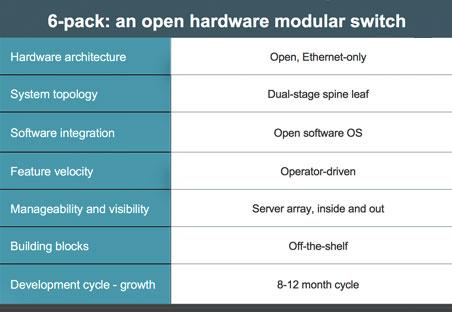
Facebook have been building their own networks, breaking down traditional network components and rebuilding them into modular disaggregated systems that provide them with the flexibility, efficiency, and scale they need.
“As Facebook’s infrastructure has scaled, we’ve frequently run up against the limits of traditional networking technologies, which tend to be too closed, too monolithic, and too iterative for the scale at which we operate and the pace at which we move,” says Facebook in their blog launching the open modular switch platform.
The “6-pack” platform is the core of their new fabric, and it uses “Wedge” as its basic building block. It is a full mesh non-blocking two-stage switch that includes 12 independent switching elements. Each independent element can switch 1.28Tbps.
This has two configurations: one configuration exposes 16x40GE ports to the front and 640G (16x40GE) to the back, and the other is used for aggregation and exposes all 1.28T to the back. Each element runs its own operating system on the local server and is completely independent, from the switching aspects to the low-level board control and cooling system.
This means any part of the system can be modified with no system-level impact, software or hardware.
“With “6-pack,” we have created an architecture that enables us to build any size switch using a simple set of common building blocks. And because the design is so open and so modular – and so agnostic when it comes to switching technology and software – we hope this is a platform that the entire industry can build on. Here's what we think separates “6-pack” from the traditional approaches to modular switches,” blog says.
6-pack is already in production testing, alongside Wedge and FBOSS. And they plan to propose the “6-pack” design as a contribution to the Open Compute Project, and they will continue working with the OCP community to develop open network technologies, says the blog.

 In
In
Add new comment